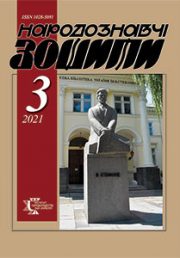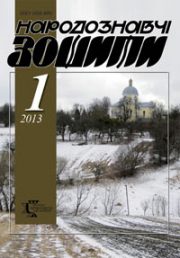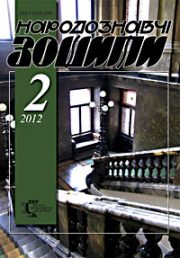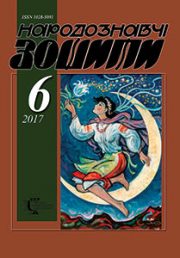The Ethnology Notebooks. 2020. № 4 (154), 907—922
UDK 303.442.43(=161.2):167-39:321.64:327.2:316.2: 81-116
DOI https://doi.org/10.15407/nz2020.04.907
KANAPLIANIKAU Dzmitry
- ORCID ID: https://orcid.org/0000-0002-4957-1619
- PhD Candidate at the
- Department of the modern ethnology of the Institute of Ethnology of the
- National Academy of Sciences of Ukraine
- Svobody Avenue 15, 79000, Lviv, Ukraine.
- Contacts: e-mail: zvyczaj@gmail.com
TOUSCIK Tacjana
- ORCID ID: https://orcid.org/0000-0001-7462-5060
- Homel society of local history«Talaka»
- Liaљиynskaja, 26, 1, 246008, Homel, Belarus
- Contacts: e-mail: tolscik@gmail.com
Abstract. Relevance. In modern-day Russia, Belarus, and the territories occupied by Russia, there is widespread racial discrimination against indigenous peoples by language. Schools in their native language are closed and activists fighting Russification are subjected to physical violence, fine, police, criminal prosecution. Many researchers do not understand why discriminate against the Belarusian language in Belarus.
The purpose of the article is to reveal this as Russian imperialism constructs its ideology through the academic schools of science formed in Russia and Belarus over the centuries of colonialism.
The used method of historiographical analysis of the imperial ideologies of ethnographic, folklore, Slavic and sociological studies of Belarusians gave the following results: with the 1960 Russian scientific schools created popular in the former USSR, the ontological foundation for Eurasian, Slavophilism, racism, for example, the Moscow-Tartu school, M. Tolstoy Slavistics School, the concept of L. Gumilyov. After 1991, in the Russian imperial ethnology was created constructivism. Also Russian Orthodox clericalism, combined with different versions of Eurasianism, became popular in the social sciences in Russia and Belarus. These racist ideologies in conjunction with the Belarusian authoritarianism created «Belarusian State Ideology», which is mandatory for use in the Belarusian universities and science.
Conclusions. These theories and concepts can not be verified, since they contain racist ideological axioms, ideological choice of sources and facts. Such studies should be considered pseudo-scientific, and their findings, methods of measurement, the facts can not be used.
Keywords: historiography of ethnology and folklore, nationalism, racism, Russification, imperialism, ideology, methodology of social sciences and humanities.
Received 26.06.2020
REFERENCES
- Ukraine v. Russian Federation, (International Court of Justice 2019). Retrieved from: https://www.icj-cij.org/en/case/166.
- Kis, Roman. (1998). The Final of Third Rome (The Russian Messianic Idea at the Turn of the Millennium). Lviv: Ethnology Institute of NAS of Ukraine [in Ukrainian].
- Kis, Roman. (1998). Measure of Eurasianism. Fragments, 4, 21—41 [in Belarusian].
- Nnaji, J., & Lujбn, J.L. (2016). The Content of Science Debate in the Historiography of the Scientific Revolution. International Studies in the Philosophy of Science, 30 (2), 99—109. https://doi.org/10.1080/02698595.2016.1265864.
- Smith, B. (2019). Internalism and Externalism in the Philosophy of Mind and Language. Retrieved from: https://www.iep.utm.edu/int-ex-ml/.
- Bird, A. (2015). Kuhn and the Historiography of Science. In Kuhn’s Structure of Scientific Revolutions — 50 Years On (Bokulich, pp. 23—38). Boston: Springer International Publishing. https://doi.org/10.1007/978-3-319-13383-6_3.
- Reisch, G.A. (2019). The politics of paradigms: Thomas S. Kuhn, James Bryant Conant, and the Cold War «Struggle for Men’s Minds». New York: State University of New York Press.
- Kuhn T.S., Hacking I. (2015). The structure of scientific revolutions. Chicago: The University of Chicago Press.
- Etkind, A. (2016). Internal Colonization: Russia’s Imperial Experience. Moscow: New literary review [in Russian].
- Kant, I. (2008). Academic edition of Immanuel Kant’s collected works, volumes and links to the table of contents (Volume VII). The faculties’ dispute, Anthropology in a pragmatic way. Retrieved from: https://korpora.zim.uni-duisburg-essen.de/kant/aa07/ [in German].
- Khurana, T. (2015). Review: Katrin Flikschuh and Lea Ypi (eds.). Kant and Colonialism: Historical and Critical Perspectives. Notre Dame Philosophical Reviews. Retrieved from: https://ndpr.nd.edu/news/kant-and-colonialism-historical-and-critical-perspectives/.
- Flikschuh, K., & Ypi, L. (2014). Kant and colonialism: historical and critical perspectives. Londra: OUP Oxford.
- Foucault, M. (2003). Introduction а l’Anthropologie de Kant. Retrieved from: http://www.generation-online.org/p/fpfoucault8.htm [in French].
- Herder, J.G. (1773). Excerpt from an exchange of letters about Ossian and the songs of old peoples. In German and Art: Some Flying Leaves (pp. 1—70). Hamburg: Bode [in German].
- Herder, J.G. (1779). Folk songs: Intermingled other pieces (Vol. 2). Leipzig: Weygand [in German].
- Herder, J.G. (1778). Folk songs (Vol. 1). Leipzig: Weygand [in German].
- Noyes, J.K. (2015). Herder: aesthetics against imperialism. Toronto: University of Toronto Press.
- Zipes, J. (2014). Grimm legacies: the magic spell of the Grimms’ folk and fairy tales. Princeton: Princeton University Press.
- Bendix, R., & Hasan-Rokem, G. (2012). A companion to folklore. Wiley-Blackwell.
- Baycroft, T., & Hopkin, D.M. (2012). Folklore and nationalism in Europe during the long nineteenth century. Leiden; Boston: Brill.
- Gobineau, A., Belfond, P. (Ed.). (1967). Essay on the Inequality of the Human Races. Chicoutimi: J.-M. Tremblay. Retrieved from: https://doi.org/10.1522/cla.goj.ess [in French].
- Miles, R., & Brown, M. (2003). Racism. London; New York N.Y.: Routledge.
- Gracia, J.J.E. (2017). Race and Ethnicity. In The Oxford handbook of philosophy and race (Pp. 180—190). New York, NY: Oxford University Press.
- Ryabchuk, M. (2013). The abolition of colonialism: the applicability of post-colonial methodology to the study of post-communist Eastern Europe. Scientific Notes of the I.F. Kuras Institute of Political and Ethno-National Studies, 2, 41—58 [in Ukrainian].
- Ryabchuk, M. (2011). Postcolonial syndrome. Observation. Kyiv: KI.S. [in Ukrainian].
- Troyan, S. (2014). Postcolonial Studies: Ukraine in Postcolonial Studies. Miscellanea Posttotalitariana Wratislaviensia, 2, 61—74 (Vol. 2). Postkolonializm — Tozsamosc — Gender [in Ukrainian].
- Thompson, E.M. (2000). Imperial knowledge: Russian literature and colonialism. Westport: Greenwood Press.
- Barthes, R. (1957). Mythologies. Paris: Editions du Seuil [in French].
- Velychenko, S. (2009). Issues of Russian colonialism in Ukrainian thought. Political dependence, identity and economic development. East-West: Historical and Cultural Collection, 13—14, 300—344 [in Ukrainian].
- Velychenko, S. (2017). Painting Imperialism and Nationalism Red. The Ukrainian Marxist Critique of Russian Communist Rule in Ukraine (1918—1922). Lviv: UCU Publishing House [in Ukrainian].
- Velychenko, S. (2005). Postcolonialism, Europe and Ukrainian History. Modern Ukraine, 9, 237—248 [in Ukrainian].
- Cvikevich, A., & Lees, A. (1993). «West-Russizm»: Sketches from the history of social thought in Belarus in the XIX and early XX century. Minsk: Education and technology [in Belarusian].
- Cvikevich, A. (1922). «Eurasians» (new quest of Russian thought). Belarusian flag, 4, 38—44 [in Belarusian].
- Melnikau, I. (2012). West-Russism as a manifestation of Russian imperial ideology in modern Belarus. Retrieved from: http://inbelhist.org/zaxodnerusizm-yak-prayava-rasijskaj-imperskaj-idealogii-ў-suchasnaj-belarusi/ [in Belarusian].
- Lewis, S. (2019). Belarus–alternative visions: nation, memory and cosmopolitanism. Abingdon: Routledge.
- Torbakov, I., & Plokhy, S. (2018). After empire: nationalist imagination and symbolic politics in Russia and Eurasia in the twentieth and twenty-first century. Stuttgart: Ibidem-Verlag.
- Laruelle, M. (2019). Russian nationalism: imaginaries, doctrines, and political battlefields. London: Routledge.
- Laruelle, M. (2012). Russian Eurasianism: an ideology of empire. Washington: DC Woodrow Wilson Center Press.
- Said, E.W. (1994). Culture and imperialism. New York: Vintage Books.
- Said, E.W. (2003). Orientalism (25th Anniv). London: Penguin Books.
- Said, E.W., & Barsamian, D. (2003). Culture and resistance: conversations with Edward W. Said. Cambridge: South End Press.
- McCarthy, c. (2010). The Cambridge introduction to Edward Said. Cambridge: Cambridge University Press.
- Phillipson, R. (1992). Linguistic imperialism. Oxford: Oxford University Press.
- Dumont, L. (1983). Essays on Individualism: Modern Ideology in Anthropological Perspective. Paris: Editions du Seuil [in French].
- Haugbolle, S. (2018). Anthropology and Political Ideology. In The Handbook of Political Anthropology (Pp. 121—191). Cheltenham, UK: Edward Elgar Publishing.
- Nadeau, K. (2011). Ideology and Anthropology. In 21st Century Anthropology: A Reference Handbook (Pp. 453—462). Thousand Oaks, California, United States: SAGE Publications, Inc. Retrieved from: https://doi.org/10.4135/9781412979283.n46.
- Fanon, F., Chevalier, H., & Maspero, F. (1988). Toward the African revolution: political essays. New York: Grove Press.
- Fanon, F. (1952). Black Skin, White Masks. Éditions du Seuil [in French].
- Rabaka, R. (2010). Forms of Fanonism: Frantz Fanon’s critical theory and the dialectics of decolonization. Lexington Books.
- Fanon, F. (2014). Racism and culture. Retrieved from: https://vpered.wordpress.com/2014/06/19/fanon-racisme-et-culture/ [in Ukrainian].
- Fanon, F. (1956). Racism and culture. African presence, 8/10, 122—131 [in French].
- Bahdanoviи, A.E. (1995). Remnants of the ancient worldview of Belarusians: Ethnographic essay. Minsk: Belarus [in Russian].
- Shane, p. V. (1874). Belarusian folk songs with rituals, customs and superstitions related to them, with an explanatory dictionary and grammatical notes attached. St. Petersburg: p. Maykov Printing House [in Russian].
- Kolberg, O. (1968). The Complete Works (T. 52. Belarus-Polesie). Warsaw: People’s Publishing Cooperative. Warszawa: Ludowa Spóіdzielnia Wydawnicza [in Polish].
- Dolega-Chodakowski, Z. (1967). About Slavic Christianity: and other letters and manuscripts. Warsaw: State Scientific Publishing House [in Polish].
- Romanov, E.R. (1912). Belarusian collection (Vol. 1—9). Kiev: Type. S.V. Kulzhenko [in Russian].
- Dobrovolsky, V.N. (1891). Smolensk Ethnographic Collection (P. I). Stories and tales. St. Petersburg: E. Evdokimov Printing Рouse [in Russian].
- Dobrovolsky, V.N. (1914). Smolensk Regional Dictionary. Smolensk: p. A. Silin Printing Рouse [in Russian].
- Tolstaya, S.M. (Ed.). (2018). Slavic ethnolinguistics. Bibliography. Department of Ethnolinguistics and Folklore; Institute of Slavic Studies of the Russian Academy of Sciences. Retrieved from: https://inslav.ru/sites/default/files/etnolingvistika_bibliografija_2018.pdf [in Russian].
- Lotman, Yu.M. (1995). Pushkin. St. Petersburg: Art-SPb. [in Russian].
- Tolstoy, N.I., & Tolstaya, S.M. (2013). Slavic ethnolinguistics: theory questions: Towards the Second All-Russian Conference of Slavists. Moscow, November 5–6, 2013. Moscow: Institute of Slavic Studies of the RAS [in Russian].
- Tolstoy, N. I. (1988). History and structure of Slavic literary languages. Moscow: Science [in Russian].
- Tolstoy, N.I. (1995). Language and Folk Culture: Essays on Slavic mythology and ethnolinguistics. Moscow: Indrik [in Russian].
- Tolstoy N.I. (2003). Essays on Slavic paganism. Moscow: Indrik [in Russian].
- Tolstoy, N., Agapkina, T.A., & Tolstaya, S.M. (Eds.). (1995). Slavic antiquities: ethnolinguistic dictionary: in 5 volumes (Vol. 1). Moscow: International Relations [in Russian].
- Ivanov, V.V. (1999). About Roman Jacobson. (Chapters from memories). Retrieved from: https://magazines.gorky.media/zvezda/1999/7/o-romane-yakobsone-glavy-iz-vospominanij.html [in Russian].
- Vroon, R., & Pilshchikov, I. (2018). V.V. Ivanov as a researcher of Russian and world literature. Retrieved from: https://www.nlobooks.ru/magazines/novoe_literaturnoe_obozrenie/153/article/20141/ [in Russian].
- Glebov, S. (2009). Eurasianism between Empire and Art Nouveau: History in documents. Moscow: New Publishing House [in Russian].
- Seriot, p. (2014). Structure and totality: the intellectual origins of structuralism in Central and Eastern Europe. Boston: De Gruyter Mouton.
- Seriot, p. (1999). Structure and totality: the intellectual origins of structuralism in Central and Eastern Europe. Paris: University Press of France [in French].
- Khalilullov, G., &Gumilyov, L. N. (1999). «I do not consider myself a gloomy type». Interview with Lev Gumilyov. Retrieved from: http://gumilevica.kulichki.net/articles/Article35.htm [in Russian].
- Shnirelman, V.A. (2011). The threshold of tolerance: ideology and practice of a new racism (Vol. 1). Moscow: New Literary Review [in Russian].
- Palkin, A.G. (2009). The concept of the state in the doctrine of the Eurasians: PhD Abstract. Ural Academy of Public Administration, Omsk [in Russian].
- Toporov, V.N. (1991). Nikolai Sergeevich Trubetskoy — scientist, thinker, person: On the occasion of the 100th anniversary of his birth (Part 2). Soviet Slavic Studies, 1, 78—99 [in Russian].
- Ivanov, V.V., & Toporov, V.N. (1974). Research in the field of Slavic antiquities. Lexical and phraseological questions of the reconstruction of texts. Moscow: Science [in Russian].
- Toporov, V.N. (1990). The importance of the Belarusian Area in ethnogenetic studies. In Birila, M. (Ed.), The Slavs: unity and diversity: International conference (Minsk, 24—27 May 1990): Abstracts i messages. Section 2. Ethnogenesis of Slavs (Pp. 87—90). Minsk [in Russian, Belarusian].
- Bartminski, J. (2016). On current tasks of ethnolinguistics.Ethnolinguistics, 28, 7—30. Retrieved from: https://doi.org/10.17951/et.2016.28.7 [in Polish].
- Zinken, J. (2016). What data does comparative ethnolinguistics need? Ethnolinguistics, 28, 334—335. Retrieved from: https://doi.org/10.17951/et.2016.28.334 [in Polish].
- Frolova, O., Yudin, A.V., Aydachich, D., Nagorko, A., Chlebda, W., Antropov, N., & Bartmiсski, J. (2016). Summary project discussion «Analysis Methods for Studying Language Image of the World in the context of comparative research». Ethnolinguistics, 28, 337. Retrieved from: https://doi.org/10.17951/et.2016.28.337 [in Polish]
- Niebrzegowska-Bartminska, S. (2017). What data is relevant ethnolinguistically? Ethnolinguistics, 29, 11—30. Retrieved from: https://doi.org/10.17951/et.2017.29.11 [in Polish].
- Bernard, H.R. (2011). Research methods in anthropology: qualitative and quantitative approaches. Lanham; Maryland: AltaMira Press.
- Bartminski, J. (1996). Dictionary of stereotypes and folk symbols (T. 1). Kosmos. (Part 1). Sky, blue lights, fire, stones). Lublin: Pub. house UMCS [in Polish].
- Bartminski, J. (2007). Language basics of the Image of the World. Lublin: Pub. house UMCS [in Polish].
- Cohen, H., & Lefebvre, c. (Eds.). (2005). Handbook of categorization in cognitive science. Amsterdam: Elsevier.
- Duranti, A. (1997). Linguistic anthropology. Cambridge: Cambridge University Press.
- Novozhilov, A.G. (2012). Problems of development of the L.N. Gumilyov Passionary theory of ethnogenesis. Vestnik St. Petersburg University. Special issue for the 100th Birthday of L.N. Gumilyov (Pp. 164–176) [in Russian].
- Bassin, M. (2016). The Gumilev mystique: biopolitics, Eurasianism, and the construction of community in modern Russia. Ithaca: Cornell University Press.
- Rich, V. (1995). Anthropology Institute Accused of Racism. Science, 269 (5220), 27—27. Retrieved from: https://doi.org/10.1126/SCIENCE.269.5220.27.
- Solovey, V.D. (2008). Blood and Soil of Russian history. Moscow: Rus. Mir [in Russian].
- Solovey, T., & Solovey, V. (2011). The failed revolution. Moscow: AST; Astrel [in Russian].
- Solovey, T., & Solovey, V. (2009). To the understanding of Russian. Retrieved from: http://www.za-nauku.ru/index.php?option=com_content&task=view&id=1709&Itemid=33 [in Russian].
- Solovey, V. (2007). «We» and «They». Retrieved from: http://www.za-nauku.ru/index.php?option=com_content&task=view&id=292&Itemid=36 [in Russian].
- Morozov, E.F. (2007). Religion — races — ethnic groups. In Faith. Ethnos. Nation. The religious component of ethnic consciousness (Pp. 35—64). Moscow: The Cultural Revolution [in Russian].
- Balushok, V. (1999). Ethnic and national: dynamics of interaction. Sociology: Theory, Methods, Marketing, 1, 93—107 [in Russian, Ukrainian].
- Anderson, B.R.O. (2005). Under three flags: anarchism and the anti-colonial imagination. London: Verso.
- Anderson, B.R.O. (2006). Imagined communities: reflections on the origin and spread of nationalism. London; New York: Verso.
- Hague, E. (2011). Benedict Anderson. In Key Thinkers on Space and Place (Pp. 16—21). London: SAGE.
- Uk.wikipedia.org. (2019). Tishkov Valeriy Oleksandrovich. Retrieved from: https://uk.wikipedia.org/wiki/Тишков_Валерій_Олександрович [in Russian].
- Tishkov, V., & Zvyagina, E. (2000). A nation is a metaphor. Ekaterina Zvyagina conversation with Valery Tishkov, Director of the Institute of Ethnology and Anthropology of the RAS. Retrieved from: http://www.valerytishkov.ru/cntnt/publikacii3/novye_publikacii/naciya__et1.html [in Russian].
- Tishkov, V.A. (2003). Requiem for Ethnicity: Studies in socio-cultural anthropology. Moscow: Science [in Russian].
- Tishkov, V.A. (2010). Russian people. A book for the teacher. Moscow: Enlightenment [in Russian].
- Tishkov, V. (2016). Nation and national identity in Russia. Bulletin of the Russian Nation, 51, 7—15 [in Russian].
- Martynova, M.Yu. (2019). Linguistic diversity of the population of Russia and the problem of school education. In XIII Congress of Anthropologists and Ethnologists of Russia: Conf. Proc. Kazan, July 2—6, 2019 (Pp. XIV—XXII). Moscow: IEA RAS; KFU [in Russian].
- Zagrebin, A.E., & Martynova, M.Yu. (Eds.). (2017). XII Congress of Anthropologists and Ethnologists of Russia: Conf. Proc. Izhevsk, July 3—6, 2017. Moscow: IEA RAS [in Russian].
- Martynova, M.Yu. (Ed.). (2019). XIII Congress of Anthropologists and Ethnologists of Russia: Conf. Proc. Kazan, July 2—6, 2019. Moscow: IEA RAS [in Russian].
- Grigoryeva, R.A. (2012). At the crossroads of cultures of three East Slavic peoples. In M.Yu. Martynova (Ed.). Borders, Culture, and Identity. Ethnology of the East Slavic borderland (Pp. 15—53). Moscow: IEA RAS [in Russian].
- Kruk, I.I. (2007). Authentic folklore of Belarusians as the Hypertext national spirit. In Authentic folklore: problems of existence, study, imitation: Materials Scientific Conference (15—16 March 2007) (Pp. 77—84). БГУКІ. Retrieved from: http://repository.buk.by/handle/123456789/4311 [in Belarusian].
- Kruk, J., & Kotovich, O. (2003). Wheel of time: tradition and modernity. Minsk: Belarus [in Russian].
- Gigin, V. (2016). The idea is stronger than all armies. Retrieved from: https://souzveche.ru/articles/our-union/31568/ [in Russian].
- Lastouski, A. (2010). Russian centrism as an ideological project of Belarusian identity. Political sphere, 14, 58—79 [in Belarusian].
- Babosov E.M. (2004). Basics of the ideology of the modern state. Minsk: Amalfey [in Russian].
- Melnik, V.A. (2013). Basics of the ideology of the Belarusian state. Minsk: Higher School [in Russian].
- Dzermant, A. (2015). Belarus: features of state ideology and national identity. Retrieved from: https://www.gumilev-center.ru/belarus-osobennosti-gosudarstvennojj-ideologii-i-nacionalnojj-identichnosti/ [in Russian].
- Rudkouski, p. (2007). Belarus uprising. Vilnius: Belarusian Studies [in Belarusian].
- Kotlyarov, I.V. (Ed.). (2017). Belarusian society in the context of a civilizational-cultural code: a sociological dimension. Minsk: Bel. Navuka [in Russian].
- Kotlyarov, I.V. (2018). Socio-political situation as a factor of the civilization code. Sociological Almanac, 9, 9—14 [in Russian].
- Kotlyarov, I.V. (2017). Integration processes in the human dimension (sociological trends). Sociological Almanac, 8, 18—31 [in Russian].
- Kotlyarov, I.V. (2010). Traditional values as the basis for the development of Belarusian society. In Spiritual and moral education based on domestic cultural, historical and religious traditions and values: Proc. of the Intern. scientific-practical conf., Zhirovichi, May 27, 2010 (Pp. 13—18). Minsk: Bel.navuka [in Russian].
- Kotlyarov, I.V., Abushenko, V.L., Babosov, E.M., Baranovsky, N.A., Smirnov, V.E., & Sokolova, G.N. (2015). Belarus on the way to the future: the sociological dimension. Minsk: Bel. science [in Russian].
- Egorov, A.G., Mozheiko, M.A., Gostenin, V.I., & Sukhova, E.E. (2016). Research. Russia and Belarus through the eyes of students. Retrieved from: http://rusbelrec.smolgu.ru/issledovania/ [in Russian].







